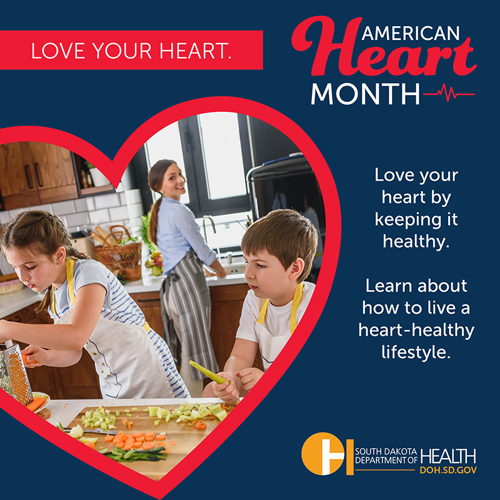February is American Heart Month
 Take action to protect yourself against heart disease. Small heart-healthy actions like adding more movement to our day or choosing healthy foods, can have a big impact on protecting our hearts.
Take action to protect yourself against heart disease. Small heart-healthy actions like adding more movement to our day or choosing healthy foods, can have a big impact on protecting our hearts.
Fast Facts
- Heart Disease is the leading cause of death for men and women in the United States.
- One person dies every 33 seconds in the United States from cardiovascular disease.
- In the United States, someone has a heart attack every 40 seconds.
Find more Heart Disease Facts (CDC) Find Heart Disease Resources (CDC)
About Heart Disease
There are several types of heart conditions. The most common type of heart disease in the U.S. is coronary artery disease (CAD), which affects blood flow to the heart and can lead to a heart attack.
Sometimes heart disease may be “silent” and not diagnosed until a person experiences signs or symptoms of a heart attack, heart failure, or an arrhythmia.
Sometimes heart disease may be “silent” and not diagnosed until a person experiences signs or symptoms of a heart attack, heart failure, or an arrhythmia. When these events happen, symptoms may include
- Heart attack: Chest pain or discomfort, upper back or neck pain, indigestion, heartburn, nausea or vomiting, extreme fatigue, upper body discomfort, dizziness, and shortness of breath.
- Arrhythmia: Fluttering feelings in the chest (palpitations).
- Heart failure: Shortness of breath, fatigue, or swelling of the feet, ankles, legs, abdomen, or neck veins.
High blood pressure, high blood cholesterol, and smoking are key risk factors for heart disease. Several other medical conditions and lifestyle choices can also put people at a higher risk for heart disease, including
Learn about how heart disease and mental health disorders are related.
By living a healthy lifestyle, you can help keep your blood pressure, cholesterol, and blood sugar levels normal and lower your risk for heart disease and heart attack.
Heart-Healthy Habits
Choose Healthy Foods & Drinks: Choose healthy meals and snacks to help prevent heart disease and its complications. Be sure to eat plenty of fresh fruits and vegetables and fewer processed foods.
- Find Heart-Healthy Recipes (NIH)
- Recipes for a Heart-Healthy Lifestyle (Million Hearts)
Keep a Healthy Weight: People with overweight or obesity have a higher risk for heart disease. Carrying extra weight can put extra stress on the heart and blood vessels.
Get Regular Physical Activity: Physical activity can help you maintain a healthy weight and lower your blood pressure, blood cholesterol, and blood sugar levels. For adults, the Surgeon General recommends 2 hours and 30 minutes of moderate-intensity exercise, like brisk walking or bicycling, every week. Children and adolescents should get 1 hour of physical activity every day.
Don't Smoke: Cigarette smoking greatly increases your risk for heart disease. If you don’t smoke, don’t start. If you do smoke, quitting will lower your risk for heart disease. Your doctor can suggest ways to help you quit.
Take Charge of Your Medical Conditions: If you have high cholesterol, high blood pressure, or diabetes, you can take steps to lower your risk for heart disease.
- Check Your Cholesterol
- Control Your Blood Pressure
- Manage Your Diabetes
- Take Your Medicines as Directed
- Work with Your Healthcare Team
You Might Also Like
Heart Disease and Stroke Prevention Program
The mission of the Heart Disease & Stroke Prevention Program is to improve cardiovascular health, reduce the burden, and eliminate disparities associated.
Heart Disease and Stroke
The mission of the Heart Disease & Stroke Prevention Program is to improve cardiovascular health, reduce the burden, and eliminate disparities associated.
Cardiac Ready Communities
Discover Cardiac Ready Communities, promoting heart disease preparedness and community resilience.
Healthy Living
Eating a balanced diet of nutrient-rich foods and staying active can improve overall health. Learn how to make the right healthy choices that work for you.
